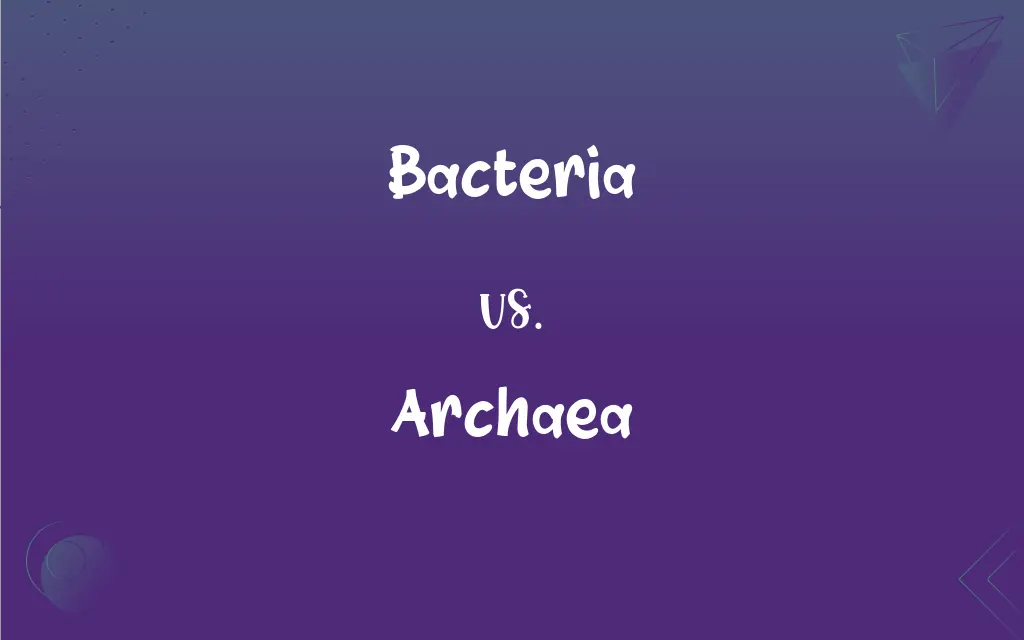Bacteria vs. Archaea: What's the Difference?
Edited by Aimie Carlson || By Harlon Moss || Updated on October 5, 2023
Bacteria and Archaea are both single-celled prokaryotes, but they differ in cell structure, genetics, and preferred environments.

Key Differences
Bacteria and Archaea, though similar in being single-celled prokaryotic organisms, are fundamentally different in many respects. Bacteria are probably more familiar to most people; they're found everywhere - in soil, water, and even inside our bodies. These microscopic organisms can either be beneficial, neutral, or harmful to other living entities, depending on the type.
Archaea, on the other hand, are often found in extreme environments, like hot springs, salt flats, or deep-sea hydrothermal vents. Originally, they were grouped with bacteria and termed "archaebacteria." However, as scientists delved deeper into their genetics and biochemistry, it became clear that Archaea were significantly different from Bacteria, leading to their classification as a separate domain of life.
At the cellular level, the membrane lipids of Bacteria and Archaea differ. While bacterial cell membranes consist of straight-chain fatty acids, archaeal membranes feature branched hydrocarbon chains. Furthermore, the cell walls of these two domains are composed of different molecules, with bacteria typically having peptidoglycan and archaea lacking it.
Genetically, there are stark differences too. Although both Bacteria and Archaea have circular chromosomes and lack a nucleus, their RNA polymerases and ribosomal RNAs differ considerably. Moreover, Archaea share some molecular mechanisms and proteins with eukaryotes (like humans), making them distinct from bacteria in this regard.
When considering antibiotic sensitivity, most antibiotics that affect bacteria don't impact archaea. This is due to the unique properties of archaeal cell walls and membranes, which render common antibiotics ineffective. This distinction underscores the fundamental differences in biology and biochemistry between Bacteria and Archaea.
ADVERTISEMENT
Comparison Chart
Cell Wall Composition
Typically contain peptidoglycan
Lack peptidoglycan; have pseudopeptidoglycan
Membrane Lipids
Straight-chain fatty acids
Branched hydrocarbon chains
Typical Habitats
Everywhere; diverse environments
Often in extreme environments
Sensitivity to Antibiotics
Many are sensitive
Generally resistant
RNA Polymerase Complexity
Simpler
More similar to eukaryotic RNA polymerases
ADVERTISEMENT
Bacteria and Archaea Definitions
Bacteria
Organisms with a simple cellular structure lacking a nucleus.
Bacteria have genetic material floating within their cell, not enclosed in a nucleus.
Archaea
Ancient life forms that share traits with both bacteria and eukaryotes.
Archaea possess enzymes similar to those in eukaryotic cells.
Bacteria
Microorganisms that reproduce by binary fission.
When conditions are right, bacteria can divide rapidly.
Archaea
Single-celled prokaryotes distinct from bacteria, often found in extreme environments.
Archaea thrive in the boiling waters of Yellowstone's hot springs.
Bacteria
Entities with a diverse range of shapes and metabolic capabilities.
Photosynthetic bacteria can capture energy from the sun.
Archaea
Organisms with unique membrane and cell wall structures.
Archaea's cell membranes help them survive in salt flats.
Bacteria
Microbes that can be pathogenic or beneficial to humans.
Some bacteria cause diseases, while others produce yogurt.
Archaea
Microbes known for their ability to live in places devoid of oxygen.
Methanogenic archaea produce methane in oxygen-free environments.
Bacteria
Single-celled prokaryotic microorganisms found everywhere.
Bacteria in our gut help digest food.
Archaea
Entities that have a unique genetic transcription mechanism.
The transcription machinery of Archaea is intricate, resembling that of eukaryotes.
Bacteria
Plural of bacterium.
Archaea
Any of various prokaryotic microorganisms of the domain Archaea, being genetically distinct from bacteria and often living in habitats with extreme environmental conditions such as high temperature or salinity. Also called archaebacterium.
Bacteria
(US) A type, species, or strain of bacterium.
Archaea
Plural of archaeon
Bacteria
Alternative form of bacterium.
Bacteria
Lowlife, slob (could be treated as plural or singular).
FAQs
Are both Bacteria and Archaea single-celled organisms?
Yes, both Bacteria and Archaea are single-celled prokaryotes.
Do bacteria have a nucleus?
No, bacteria lack a nucleus; their genetic material is in the cytoplasm.
How do bacteria protect themselves from viruses?
Some bacteria use systems like CRISPR to fend off viral invaders.
Which domain often thrives in extreme environments?
Archaea often inhabit extreme environments.
Can bacteria perform photosynthesis?
Yes, certain bacteria, like cyanobacteria, can perform photosynthesis.
Do bacteria play a role in fermentation?
Yes, certain bacteria are essential for processes like yogurt and cheese production.
Why are Archaea considered a separate domain from Bacteria?
Due to fundamental differences in genetics, cell structure, and biochemistry.
Can both Bacteria and Archaea cause diseases in humans?
While many diseases are bacterial, Archaea are generally not pathogenic to humans.
Which domain has peptidoglycan in their cell walls?
Bacteria have cell walls containing peptidoglycan.
Are Bacteria and Archaea visible to the naked eye?
Typically no, they are microscopic and require magnification to be seen.
Are all bacteria harmful to humans?
No, many bacteria are beneficial or neutral to humans.
Do antibiotics typically affect Archaea?
Most antibiotics that affect bacteria don't impact archaea.
How do the RNA polymerases of Bacteria and Archaea differ?
Archaeal RNA polymerases are more complex and resemble eukaryotic ones.
Can Archaea be found in human bodies?
Yes, some Archaea inhabit the human gut and other body sites.
Is it true that Archaea can produce methane?
Yes, methanogenic archaea produce methane in anaerobic conditions.
What's unique about the cell membranes of Archaea?
Archaeal cell membranes contain branched hydrocarbon chains.
How do Bacteria reproduce?
Bacteria typically reproduce by binary fission.
Are all Archaea extremophiles?
No, while many thrive in extreme conditions, some live in milder environments.
Where were Archaea first discovered?
Archaea were first recognized in extreme environments like hot springs.
Are Archaea ancient forms of life?
Yes, Archaea are ancient and have been around for billions of years.
About Author
Written by
Harlon MossHarlon is a seasoned quality moderator and accomplished content writer for Difference Wiki. An alumnus of the prestigious University of California, he earned his degree in Computer Science. Leveraging his academic background, Harlon brings a meticulous and informed perspective to his work, ensuring content accuracy and excellence.
Edited by
Aimie CarlsonAimie Carlson, holding a master's degree in English literature, is a fervent English language enthusiast. She lends her writing talents to Difference Wiki, a prominent website that specializes in comparisons, offering readers insightful analyses that both captivate and inform.































































